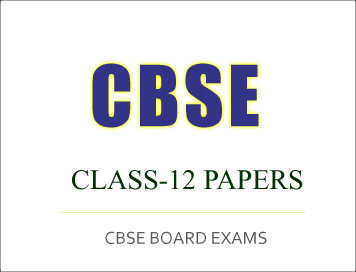CBSE Class-12 Question Papers for IOP/Comptt Examination 2017 : Delhi Scheme, History
Disclaimer: This website is NOT associated with CBSE, for official website of CBSE visit - www.cbse.gov.in

CBSE Class-12 Question Papers for IOP/Comptt Examination 2017 :
Delhi Scheme, History
CBSE Class-12 Question Papers for IOP/Comptt Examination 2017 : History, Set -1
HISTORY
Time allowed : 3 hours
Maximum Marks : 80
General Instructions :
(1) Answer all the questions. Some questions have internal choice. Marks are indicated against each question.
(2) Answer to question nos. 1 to 3 carrying 2 marks should not exceed 30 words each.
(3) Answer to question nos. 4 to 9 carrying 4 marks should not exceed 100 words. Students should attempt only 5 questions in this section.
(4) Question 10 (for 4 marks) is a value based question and compulsory question.
(5) Answer to question nos. 11 to 13 carrying 8 marks should not exceed 350 words.
(6) Questions 14 to 16 are source based questions and have no internal choice.
(7) Question 17 is a Map question that includes identification and significant test items. Attach the map with the answer-sheet.
PART – A
Answer all the questions given below :
1. Who founded the Mauryan Empire ? Mention any one source to know about him.
2. Elucidate any two features of the Kitab-ul-Hind.
3. Why was Permanent Settlement rarely extended to any other region beyond Bengal during 18th century ?. Give two reasons.
PART – B
SECTION – I
Answer any five of the following questions :
4. “Be lamps unto yourself as all of you must work out your own liberation.” In the light of the above last words of Buddha to his followers bring out his philosophy of life.
5. Describe how numismatics (Study of coins) of the sixth century B.C.E. onwards has helped the historians to reconstruct the past of the various kingdoms.
6. In what ways have the daily routine and special festivities associated with the Mughal Court conveyed a sense of power of the Mughal Emperor ? Explain.
7. Explain the features of Virupaksha temple.
8. How did the British Land Revenue policy undermined the position and authority of the Taluqdars of Awadh during early nineteenth century ? Explain.
9. Describe the causes that led to the Partition of India.
SECTION – II
Value Based Question (Compulsory)
10. Read the passage given below and answer the questions that follow :
‘Rani of Jhansi’ was represented as a masculine figure chasing the enemy, slaying British soldiers and valiantly fighting till her last. Children in many parts of India grow up reading the lines of Subhadra Kumari : “Khoob Lari Mardani Woh To Jhansi Wali
Rani thi”. In the light of the above passage highlight the values upheld by Rani of Jhansi.
PART – C
Long Answer Questions
Answer all the questions given below :
11. Describe the evidences that suggests that Brahminal prescriptions about Kinship, Patriarchy and marriages were not universally followed during Mahabharata period.
OR
Highlight the elements considered by the historians while analyzing the Mahabharata. Explain B.B. Lal’s search for convergence in this regard.
12. Examine Ain-i-Akbari as the culmination of large historical and administrative project of Akbar’s empire.
OR
Examine the vitality of Mughal Land Revenue System as an administrative apparatus.